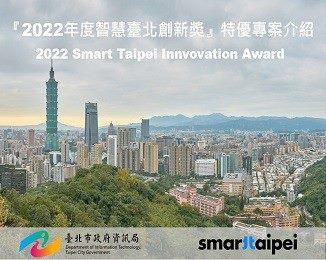The Overview of "2022 Smart Taipei Innovation Award" Exceptional Projects
Since 2016, Taipei city government has routed many private units to city government’s related departments for public-private collaboration through "Taipei Smart City Industrial Field Empirical PoC Program", which successfully contributes to many innovative PoC Program projects and motivates many industries to realize innovation and facilitates Taipei city toward a smart city. The expense of execution for these PoC projects matched by this plan was totally raised by these partners on their own. In order to encourage and appreciate the industries and academic institutions for their participation in Taipei city innovative development. The first "Smart Taipei Innovation Award" was launched by Dept. of Information Technology, Taipei City Government in 2020, we present the awards to those partners contributing to city’s innovative development through this annual distinguished PoC projects selection. This year, quite a few excellent projects were proposed by the related city government departments for "2022 Smart Taipei Innovation Award". These PoC projects were reviewed and evaluated internally and externally in terms of their innovation, planning inclusion, field experiment benefit, future feasibility and data integrity. Through two sections of review, first on the documents and second on the presentation, 10 projects were awarded this year, among them, 3 and 7 projects were selected as exceptional and distinguished respectively. The briefings of the three exceptional projects are described as follows: 1.Smart traffic accident spot positioning software_ PoCGaea Technology Co., Ltd. This PoC project takes advantage of information and communication soft/hardware integrated portable convenience device with high precision positioning and measurement to replace the range finding wheel and manual drawing so as to quickly digitalize the accident spot map and reduce the time to generate the final site map. The user just opens the smart phone APP on a portable device, sets up at least two reference points on the spot and then marks any trace evidence by clicking on the real-time screen, together with on-site photos to make the accident spot record more detailed. User trace evidence range definition is additionally provided for the user to record and graphically present the car in the accident by a square on the system. The system will overlay the collected data to the drawing system for the digitalization process by means of reference PoC alignment. Two reference point alignment and vector position twisting enable the measured objects to be integrated into the map and save many complicated procedures from scratch. 2.PoC project of the battery-swap type traffic signaling UPS_ Gogoro Network (Cayman), Taiwan Branch This project is a solution to situations where traffic signals suffer an unexpected or planned blackout. It can minimize the impact on the road traffic in Taipei city and verify Gogoro LiNiCoMnO2 battery with high-level safety spec. In addition to fulfill the needs for electric motorcycle energy replenishment, it can further be applied as the electric source reserved for utilities. Through remote and real-time monitoring platforms and LINE message connection, the authority can promptly control the actual operation of the traffic signaling UPS at intersections. 3.Hydraulic modeling application and engineering maintenance system expansion for tap water pipe network_ CECI Engineering Consultants, Inc., Taiwan Since 2017, the Taipei Water Department has implemented the project of “GIS application expansion and decision-making support” to integrate the internal and external utilities, tap water pipes, valve management, real-time construction information, high precision topographic maps, cadastral maps, house numbers, water bill databank, customer service databank, material databank, property databank, monitoring databank and other spatial information and build up the intelligent Taipei tap water information management system. Through the WebGIS system, it can immediately output the basic information required for a pipe network hydraulic model and takes the water supply areas in Dazhi and Neihu as a demonstration site to establish, calibrate, simulate and analyze the hydraulic model. It has made a great achievement. This project persists in building up the hydraulic model for the water supply area based on previous achievements. Moreover, it also improves the tap water map information and real-time application of hydraulic analysis results which integrates the hydraulic analysis software device into the “intelligent Taipei tap water information management system”. It combines with real-time monitoring data to conduct emulate (Live) modeling research and trial to simulate the water pressure and flow in a pipe network of a water supply area. Real-time hydraulic modeling system planning is achieved through the process of trial and verification. In the future, through big data statistical analysis, the system can collect base values from 24-hour monitoring data instantly depending on historical data as future warning values. When any data shows an exception, it can be displayed on the system map. Combined with the tracing analysis, personnel in the monitor center can understand the impact range and make a supporting decision. It can also real-time alarms when water pressure is not sufficient so as to reduce disaster risk. GIS application expansion and service integration enhance the system application level and increase reference information for decision-making.


![Taiwan.gov.tw [ open a new window]](/images/egov.png)
